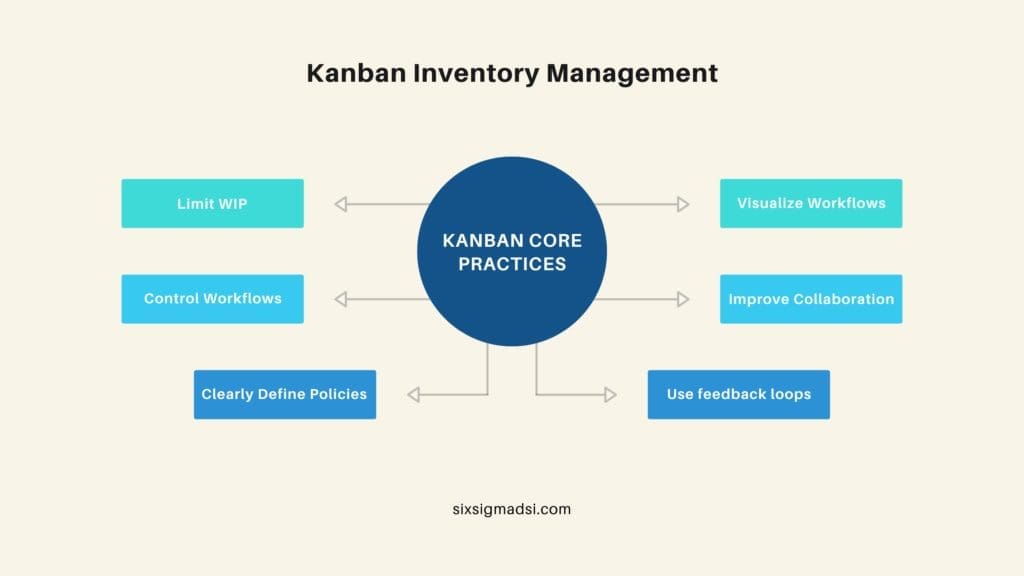Table of contents
- What is Kanban Inventory Management?
- Kanban Core Practices
- Common Problems in Supply Management and Inventory Management
- Kanban Inventory Guidelines
- Why use a Kanban Inventory Management Application?
- Create specific Kanban projects based on your inventory type
- Kanban Cards to Identify Inventory Items
- Related articles
What is Kanban Inventory Management?
A Kanban inventory management system is a Lean method that ensures you only stock what is needed, when it is needed. As a result, businesses avoid overproduction, reduce waste, and free up warehouse space.
Taiichi Ohno, an engineer at Toyota, created the Kanban method more than 70 years ago. He introduced visual Kanban boards and cards to manage production and materials. This system allowed Toyota to order and restock only when necessary. Because of this approach, Toyota grew rapidly and set a new standard for efficiency.
Today, companies in manufacturing, healthcare, and supply chains use Kanban inventory systems. They do so to cut costs, improve responsiveness, and gain a competitive advantage.
Core Practices in The Kanban System

Kanban relies on several core practices that make workflows visible and efficient.
1. Visualize Workflows
Teams must illustrate every step of the process with clear visual cues. For example, sticky notes or colored cards can represent tasks. In modern workplaces, digital Kanban software performs the same role by organizing tasks in lanes and columns.
2. Limit Work in Progress (WIP)
Kanban reduces WIP by requiring teams to finish current tasks before starting new ones. Therefore, bottlenecks shrink, efficiency increases, and inventory stays balanced with actual demand.
3. Control Workflows
When managers monitor workflows, they can spot weaknesses early. For example, forecasting production and resource use prevents shortages and improves customer commitments. In this way, Kanban keeps processes reliable and predictable.
4. Define Policies Clearly
Teams set clear expectations for every step. In addition, Kanban cards show ownership, checklists, and transition criteria. Workers know exactly what to do, who is responsible, and what must happen before moving forward.
5. Use Feedback Loops
Regular feedback supports continuous improvement. Teams gather data, test small changes, and apply improvements quickly. As a result, problems surface early and adjustments keep the process on track.
6. Improve Collaboration
Kanban breaks tasks into smaller cards, which forces teams to collaborate. Because of this, workers depend on each other, plan transitions carefully, and solve problems together. Any change in one area is communicated broadly so other teams stay aligned.
Common Problems in Supply Management and Inventory Management
Global supply chains often slow down because of distance, multiple facilities, or poor coordination. However, Kanban cards represent every link in the chain. This visibility makes it easier to track deliveries, align timelines, and manage orders.
Businesses also struggle when they fail to measure real needs or forecast demand. For example, carrying excess stock raises storage costs, while shortages hurt customer service. A Kanban inventory system provides a visual roadmap of what you need, when you need it, and where it belongs in the pipeline.
When managers align Kanban with business plans, they can set realistic goals and priorities. Therefore, forecasting improves, gaps shrink, and the supply chain becomes more reliable.
Kanban Inventory Guidelines
Toyota established six golden rules for Kanban inventory management:
- Do not pass defects – Teams must remove defective items before they move downstream.
- Only take what you need – Downstream processes pull just enough to meet demand.
- Produce exact quantities – Avoid excess output that clogs storage and raises costs.
- Maintain level production – Keep workflow consistent to reduce variability.
- Optimize continuously – Look for small, ongoing ways to improve efficiency.
- Stabilize processes – Standardize tasks to ensure quality and repeatability.

Why use a Kanban Inventory Management application?
Modern businesses face complex supply chains and high customer expectations. A Kanban application helps managers monitor inventory in real time and cut costs. In addition, it:
- Reduces storage expenses by keeping only what is needed.
- Speeds up response to customer demand.
- Creates simple reports that track progress.
- Keeps warehouses clean by limiting unnecessary storage.
Kanban also aligns with Lean Manufacturing principles, which focus on continuous product flow and waste reduction.
Create specific Kanban projects based on your inventory type
With Kanban software, businesses can create custom boards for each type of inventory. For instance, a shoe retailer may design a Kanban board to track inbound and outbound shoe shipments.
Traditional boards include three columns: To-Do, Doing, and Done. As tasks move across the columns, managers see progress instantly. As a result, they can spot delays, balance workloads, and ensure steady flow.
Kanban Cards to Identify Inventory Items
Every task or product in a Kanban system is tracked with a Kanban card. These cards represent shipments, production steps, or materials. Workers move them from column to column as work progresses.
Each card includes all necessary details such as supplies, responsibilities, and progress status. This way, managers maintain full visibility of inventory flow and prevent bottlenecks before they occur.
Frequently Asked Questions About Kanban Inventory Management
1. What is a Kanban Inventory Management System?
A Kanban Inventory Management System uses visual signals or cards to track materials and control stock levels. It helps teams maintain the right amount of inventory, avoid waste, and respond quickly to changes in demand.
2. How does Kanban improve inventory control?
Kanban links demand directly to supply. Each card represents a set quantity of materials. When a card is used, it signals that more stock is needed. This keeps production running smoothly and prevents both shortages and overstocking.
3. What are the main benefits of Kanban?
Kanban improves workflow, reduces costs, and increases visibility. It supports Lean manufacturing by keeping processes organized and by helping teams identify problems early.
4. How does Kanban support Just in Time (JIT) production?
Kanban ensures that materials are replenished only when needed. This aligns perfectly with Just in Time principles. It reduces storage costs, limits waste, and keeps operations flexible and efficient.
5. Can Kanban be used digitally?
Yes. Many companies use digital Kanban boards and software to automate signals and track movement. These tools make it easier to manage multiple locations and monitor performance in real time.
6. How can a company start using Kanban?
Begin with one product line or process. Use cards or a simple digital board to track work. Train your team, observe results, and expand gradually as you refine the system.
Related articles

Public, Onsite, Virtual, and Online Six Sigma Certification Training!
- We are accredited by the IASSC.
- Live Public Training at 52 Sites.
- Live Virtual Training.
- Onsite Training (at your organization).
- Interactive Online (self-paced) training,
About Six Sigma Development Solutions, Inc.
Six Sigma Development Solutions, Inc. offers onsite, public, and virtual Lean Six Sigma certification training. We are an Accredited Training Organization by the IASSC (International Association of Six Sigma Certification). We offer Lean Six Sigma Green Belt, Black Belt, and Yellow Belt, as well as LEAN certifications.
Book a Call and Let us know how we can help meet your training needs.




















